Anisotropic Deformation in the Compressions of Single Crystalline Copper Nanoparticles
Abstract
:1. Introduction
2. Materials and Methods
3. Results and Discussions
3.1. [111] Compression
3.2. [110] Compression
3.3. [112] Compression
4. Conclusions
Acknowledgments
Author Contributions
Conflicts of Interest
References
- Kim, T.; Myung, S.; Kim, T.H.; Hong, S. Robust single-nanoparticle probe for contact-mode analysis and dip-pen nanolithography. Small 2008, 4, 1072–1075. [Google Scholar] [CrossRef] [PubMed]
- Gerberich, W.W.; Mook, W.M.; Perrey, C.R.; Carter, C.B.; Baskes, M.I.; Mukherjee, R.; Gidwani, A.; Heberlein, J.; McMurry, P.H.; Girshick, S.L. Superhard silicon nanospheres. J. Mech. Phys. Solids 2003, 51, 979–992. [Google Scholar] [CrossRef]
- Zhong, Y.; Zhu, T. Simulating nanoindentation and predicting dislocation nucleation using interatomic potential finite element method. Comput. Methods Appl. Mech. Eng. 2008, 197, 3174–3181. [Google Scholar] [CrossRef]
- Zhu, T.; Li, J.; Van Vliet, K.J.; Ogata, S.; Yip, S.; Suresh, S. Predictive modeling of nanoindentation-induced homogeneous dislocation nucleation in copper. J. Mech. Phys. Solids 2004, 52, 691–724. [Google Scholar] [CrossRef]
- Tsuru, T.; Shibutani, Y. Anisotropic effects in elastic and incipient plastic deformation under (001), (110), and (111) nanoindentation of Al and Cu. Phys. Rev. B 2007, 75, 035415. [Google Scholar] [CrossRef]
- Hyde, B.; Espinosa, H.D.; Farkas, D. An atomistic investigation of elastic and plastic properties of Au nanowires. JOM 2005, 57, 62–66. [Google Scholar] [CrossRef]
- Kim, J.; Jang, D.; Greer, J.R. Crystallographic orientation and size dependence of tension-compression asymmetry in molybdenum nano-pillars. Int. J. Plast. 2012, 28, 46–52. [Google Scholar] [CrossRef]
- Weinberger, C.R.; Cai, W. Orientation-dependent plasticity in metal nanowires under torsion: Twist boundary formation and Eshelby twist. Nano Lett. 2010, 10, 139–142. [Google Scholar] [CrossRef] [PubMed]
- Liu, Q.; Shen, S. On the large-strain plasticity of silicon nanowires: Effects of axial orientation and surface. Int. J. Plast. 2012, 38, 146–158. [Google Scholar] [CrossRef]
- Rabkin, E.; Srolovitz, D.J. Onset of plasticity in gold nanopillar compression. Nano Lett. 2007, 7, 101–107. [Google Scholar] [CrossRef] [PubMed]
- Johnsion, C.; Snoeck, E.; Ezcurdia, M.; Rodriguez-Gonzalez, B.; Pastoriza-Santos, I.; Liz-Marzan, L.M.; Hytch, M.J. Effects of elastic anisotropy on strain distributions in decahedral gold nanoparticles. Nat. Mater. 2008, 7, 120–124. [Google Scholar] [CrossRef] [PubMed]
- Casillas, G.; Palomares-Baez, J.P.; Rodriguez-Lopez, J.L.; Luo, J.; Ponce, A.; Esparza, R.; Velazquez-Salazar, J.J.; Hurtado-Macias, A.; Gonzalez-Hernandez, J.; Jose-Yacaman, M. In situ TEM study of mechanical behavior of twinned nanoparticles. Philos. Mag. 2012, 92, 4437–4453. [Google Scholar] [CrossRef]
- Valentini, P.; Gerberich, W.W.; Dumitrica, T. Phase-transition plasticity response in uniaxially compressed silicon nanospheres. Phys. Rev. Lett. 2007, 99, 175701. [Google Scholar] [CrossRef] [PubMed]
- Carlton, C.E.; Ferreira, P.J. In situ TEM nanoindentation of nanoparticles. Micron 2012, 43, 1134–1139. [Google Scholar] [CrossRef] [PubMed]
- Mordehai, D.; Kazakevich, M.; Srolovitz, D.J.; Rabkin, E. Nanoindentation size effect in single-crystal nanoparticles and thin films: A comparative experimental and simulation study. Acta Mater. 2011, 59, 2309–2321. [Google Scholar] [CrossRef]
- Bian, J.J.; Wang, G.F. Atomistic deformation mechanisms in copper nanoparticles. J. Comput. Theor. Nano 2013, 10, 2299–2303. [Google Scholar] [CrossRef]
- Armstrong, P.; Knieke, C.; Mackovic, M.; Frank, G.; Hartmaier, A.; Goken, M.; Peukert, W. Microstructural evolution during deformation of tin dioxide nanoparticles in a comminution process. Acta Mater. 2009, 57, 3060–3071. [Google Scholar] [CrossRef]
- Mishin, Y.; Mehl, M.J.; Papaconstantopoulos, D.A.; Voter, A.F.; Kress, J.D. Structural stability and lattice defects in copper: Ab initio, tight-binding, and embedded-atom calculations. Phys. Rev. B 2001, 63, 224106. [Google Scholar] [CrossRef]
- Jang, D.; Li, X.; Gao, H.; Greer, J.R. Deformation mechanisms in nanotwinned metal nanopillars. Nat. Nanotechnol. 2012, 7, 594–601. [Google Scholar] [CrossRef] [PubMed]
- Zhang, Y.; Zhou, L.; Huang, H. Size dependence of twin formation energy of metallic nanowires. Int. J. Smart Nano Mater. 2013, 2, 112–118. [Google Scholar] [CrossRef]
- Tsuzuki, H.; Branicio, P.S.; Rino, J.P. Structural characterization of deformed crystals by analysis of common atomic neighborhood. Comput. Phys. Commun. 2007, 177, 518–523. [Google Scholar] [CrossRef]
- Stukowski, A. Visulization and analysis of atomistic simulation data with OVITO-the Open Visualization Tool. Model. Simul. Mater. Sci. Eng. 2010, 18, 015012. [Google Scholar] [CrossRef]
- Ahrens, J.; Geveci, B.; Law, C. ParaView: An end-user tool for large data visualization. In Visualization Handbook; Elsevier: Amsterdam, The Netherlands, 2005; ISBN 978-0123875822. [Google Scholar]
- Wang, G.F.; Bian, J.J.; Feng, J.; Feng, X.Q. Compressive behavior of crystalline nanoparticles with atomic-scale surface steps. Mater. Res. Express 2015, 2, 015006. [Google Scholar] [CrossRef]
- Yang, L.; Bian, J.J.; Wang, G.F. Impact of atomic-scale surface morphology on the size-dependent yield stress of gold nanoparticles. J. Phys. D Appl. Phys. 2017, 50, 245302. [Google Scholar] [CrossRef]
- Lee, S.; Aubry, S.; Nix, W.D.; Cai, W. Dislocation junctions and jogs in a free-standing fcc thin film. Model. Simul. Mater. Sci. Eng. 2011, 19, 025002. [Google Scholar] [CrossRef]
- Weinberger, C.R.; Cai, W. The stability of Lomer-Cottrell jogs in nanopillars. Scr. Mater. 2011, 64, 529–532. [Google Scholar] [CrossRef]
- Tucker, G.J.; Aitken, Z.H.; Greer, J.R.; Weinberger, C.R. The mechanical behavior and deformation of bicrystalline nanowires. Model. Simul. Mater. Sci. Eng. 2013, 21, 015004. [Google Scholar] [CrossRef]
- Wang, W.; Zhong, Y.; Lu, K.; Lu, L.; McDowell, D.L.; Zhu, T. Size effects and strength fluctuation in nanoscale plasticity. Acta Mater. 2012, 60, 3302–3309. [Google Scholar] [CrossRef]
- Shin, C.; Osetsky, Y.N.; Stoller, R.E. Dislocation nucleation and defect formation in copper by stepped spherical indeneter. Philos. Mag. 2012, 92, 3158–3171. [Google Scholar] [CrossRef]
- Liang, H.; Woo, C.H.; Huang, H.; Ngan, A.H.W.; Yu, T.X. Crystalline plasticity on Copper (001), (110), and (111) surface during nanoindentation. Comput. Model. Eng. Sci. 2014, 6, 105–114. [Google Scholar]
- Wang, Y.M.; Sansoz, F.; LaGrange, T.; Ott, R.T.; Marian, J.; Barbee, T.W., Jr.; Hamza, A.V. Defective twin boundaries in nanotwinned metals. Nat. Mater. 2013, 12, 697–702. [Google Scholar] [CrossRef] [PubMed]
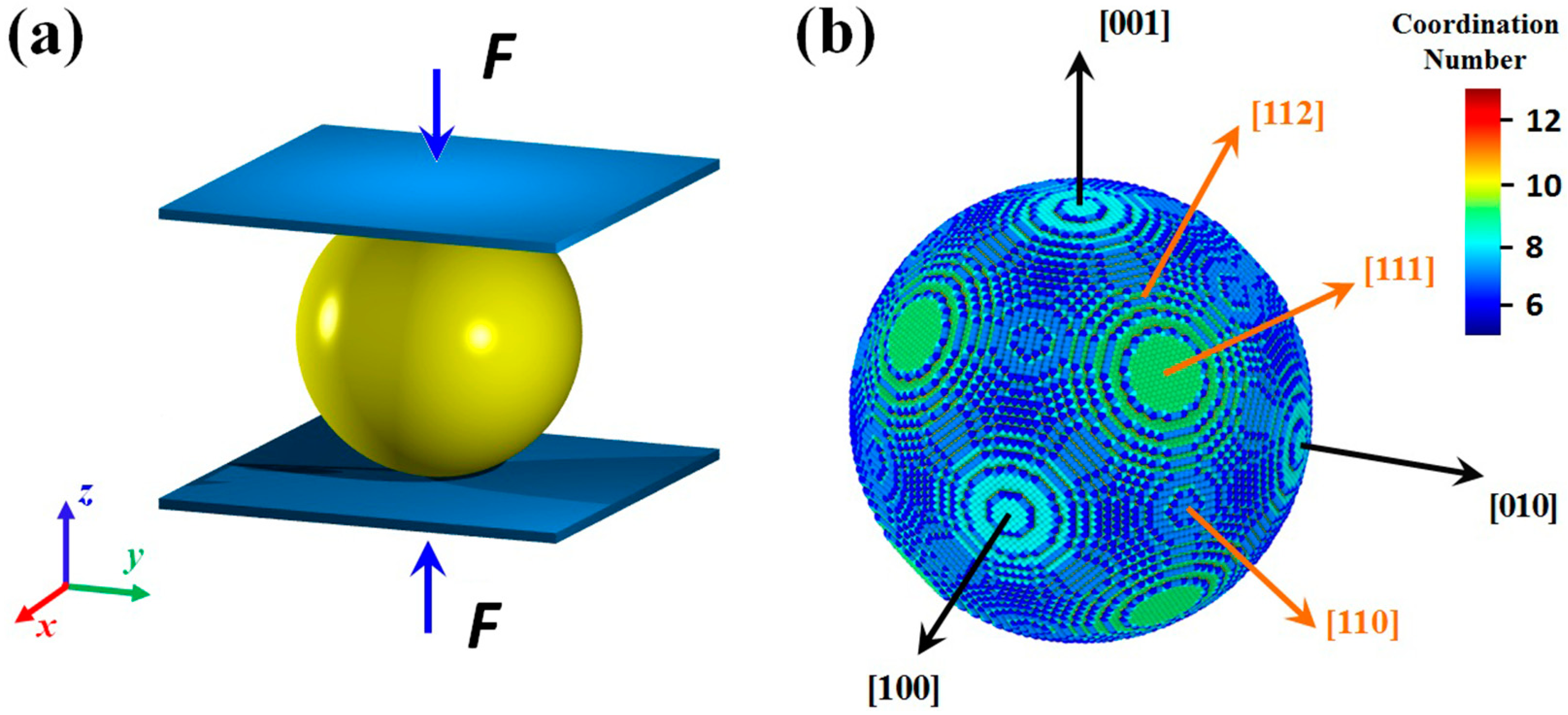
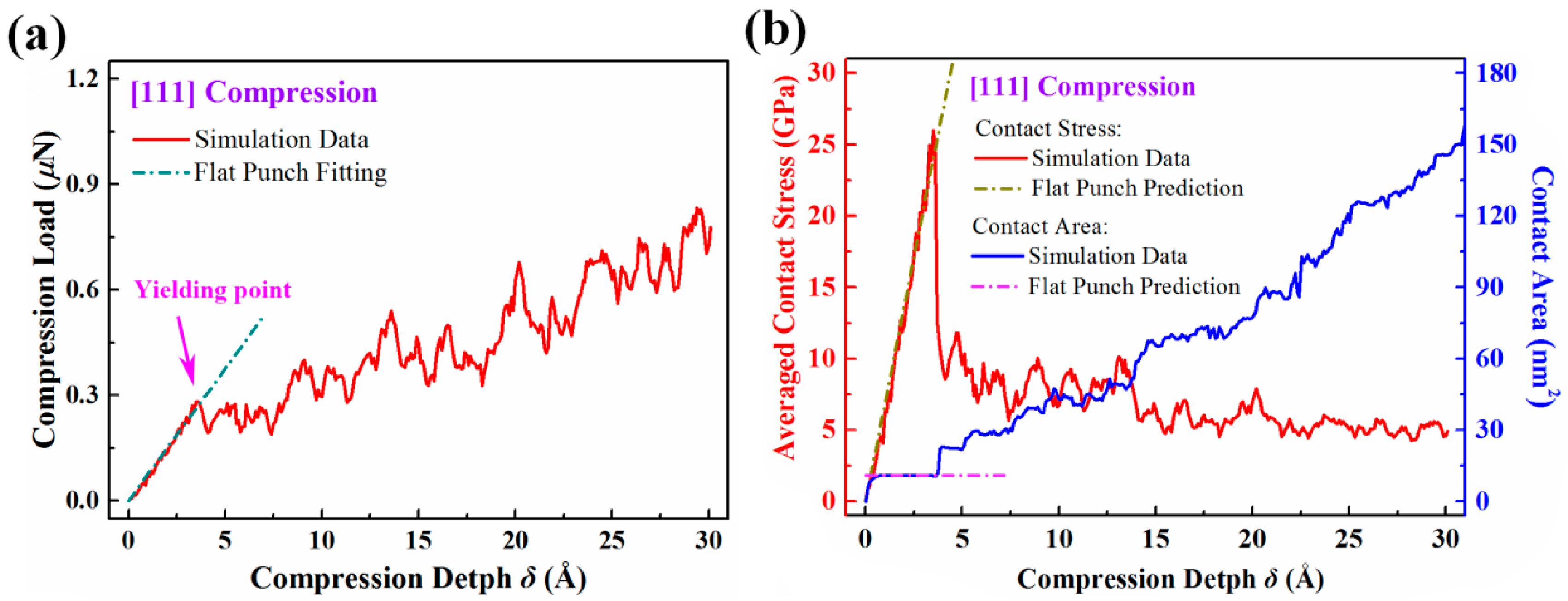
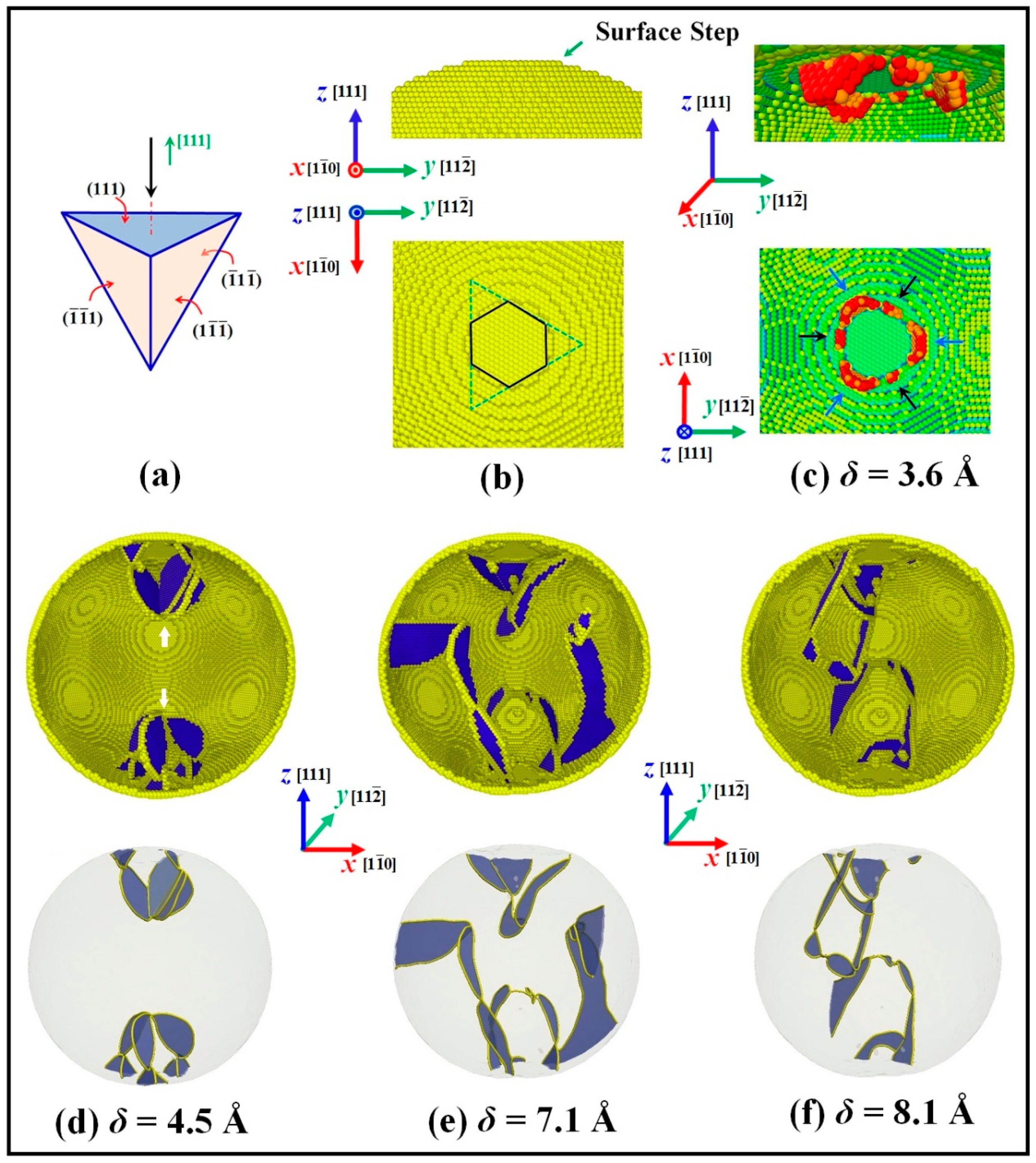

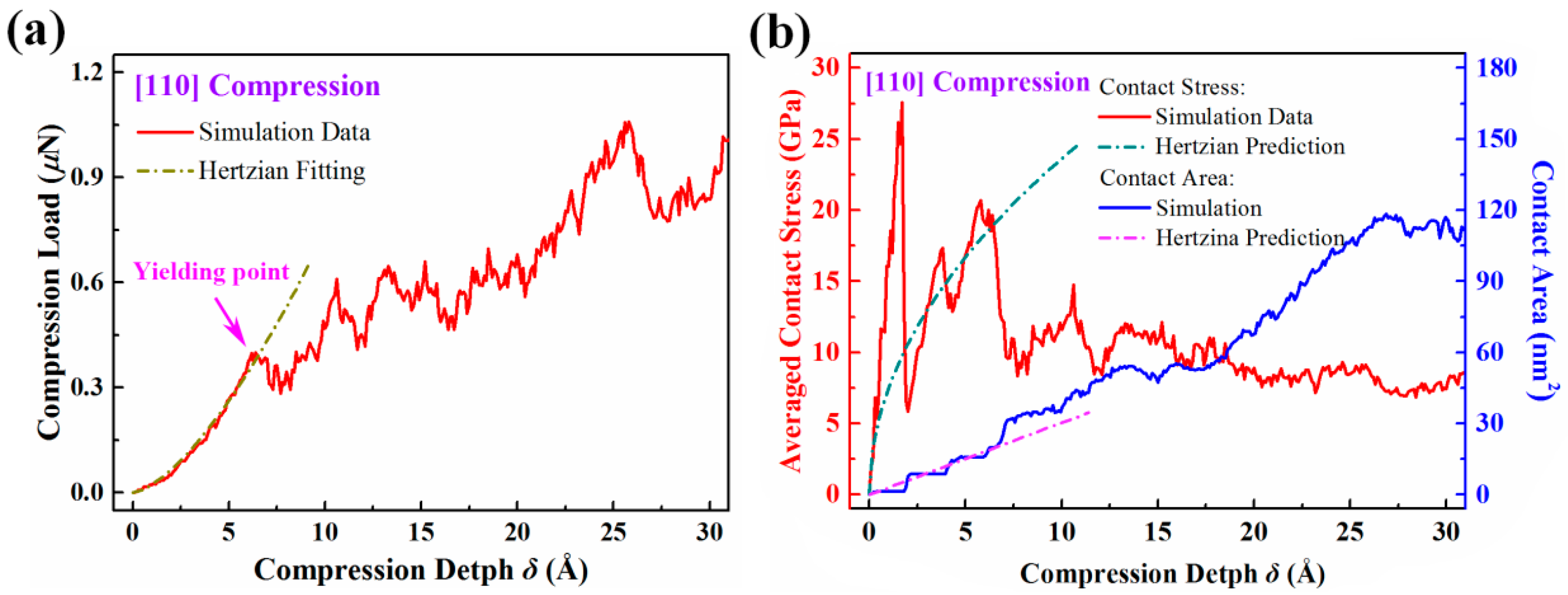
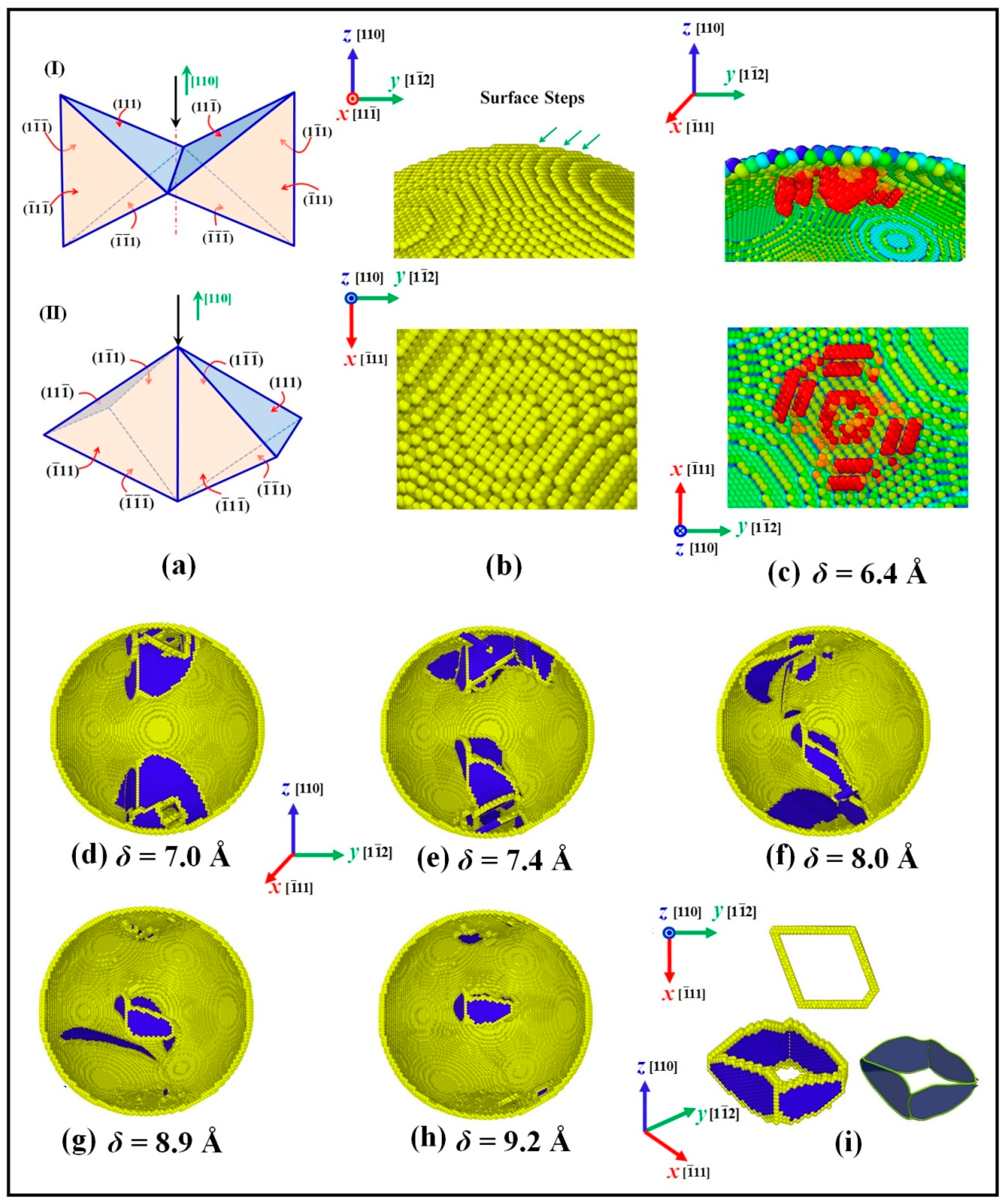
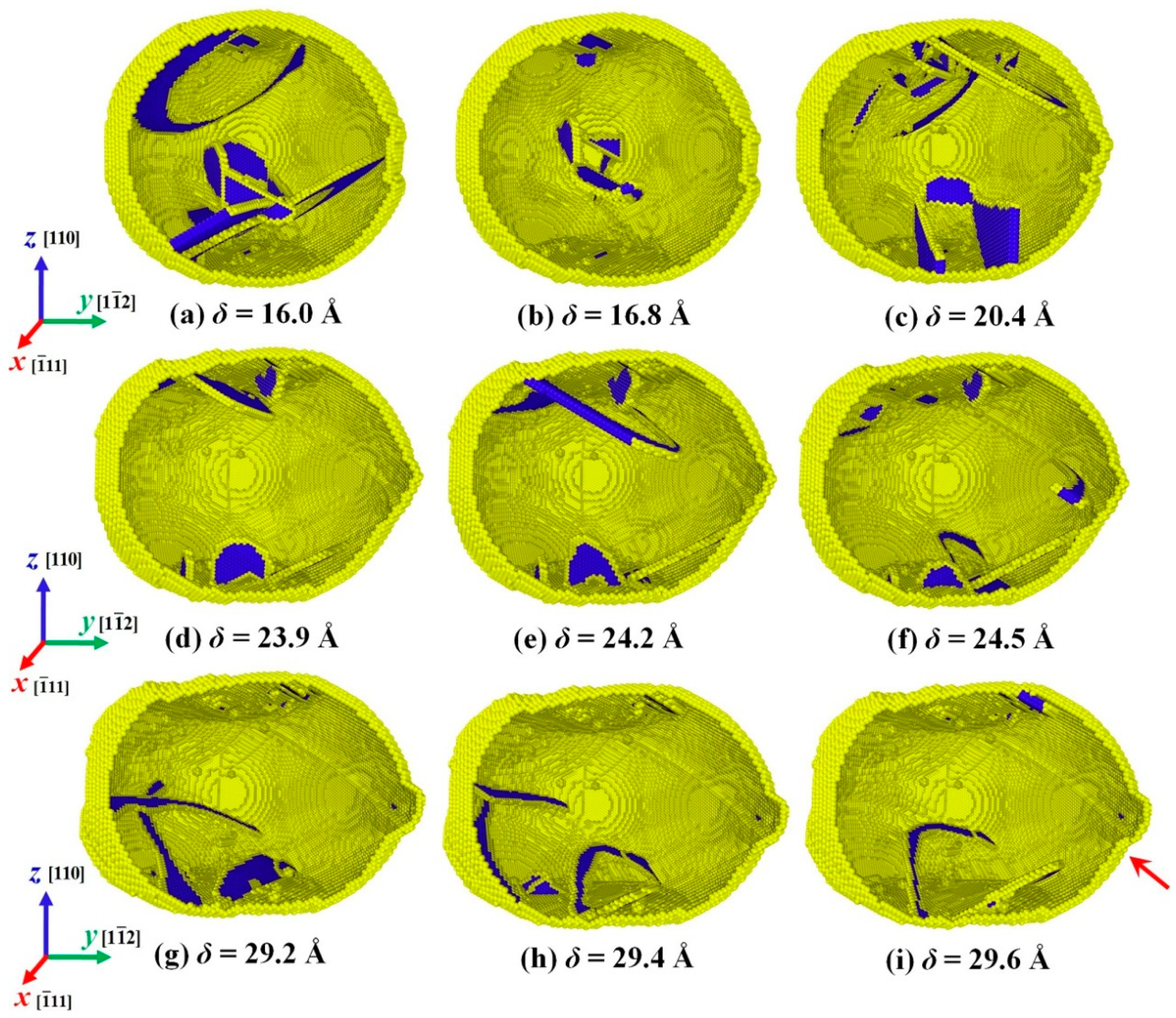
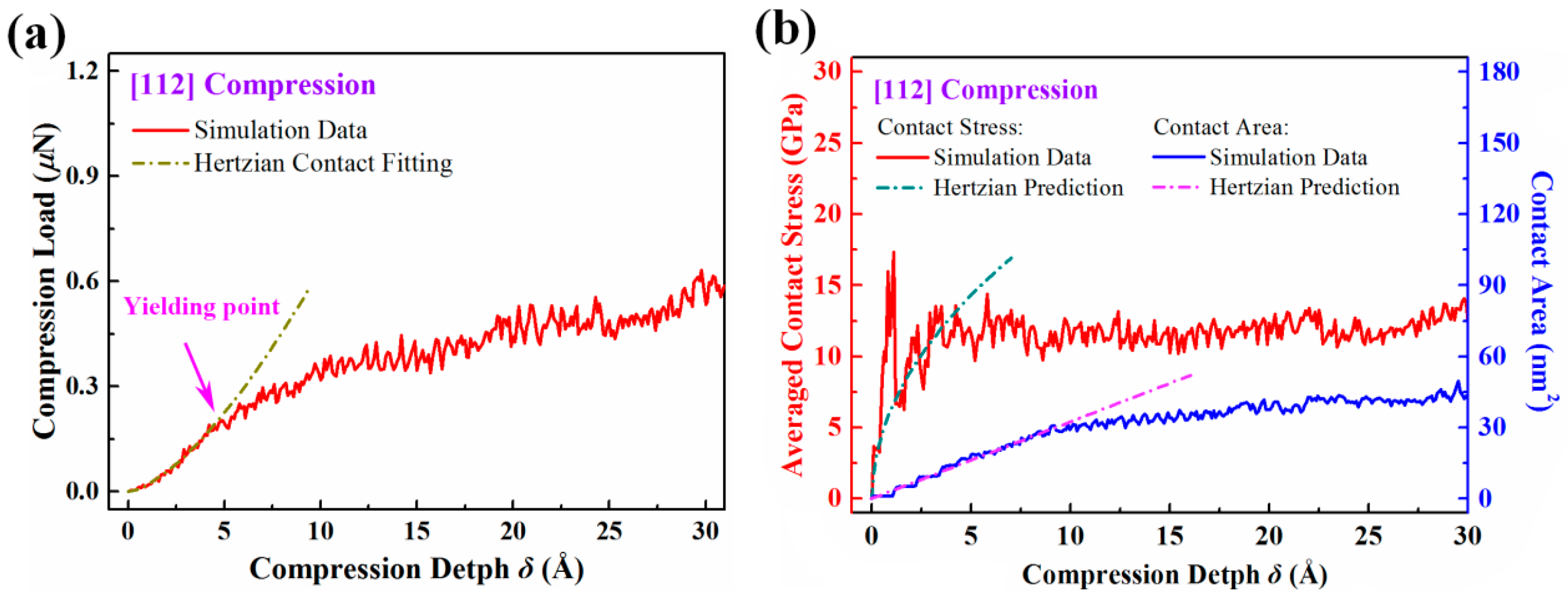
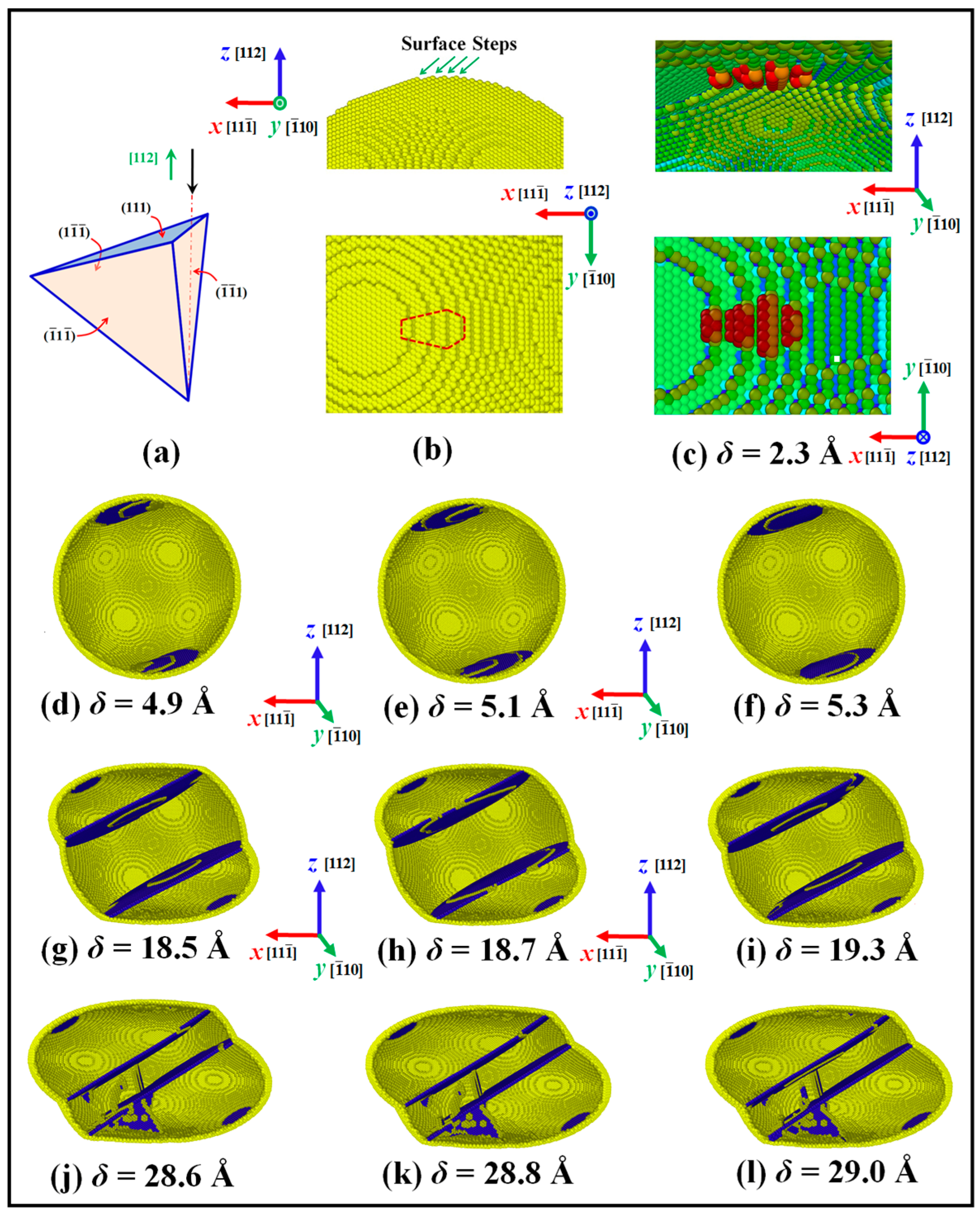
© 2018 by the authors. Licensee MDPI, Basel, Switzerland. This article is an open access article distributed under the terms and conditions of the Creative Commons Attribution (CC BY) license (http://creativecommons.org/licenses/by/4.0/).
Share and Cite
Bian, J.; Zhang, H.; Niu, X.; Wang, G. Anisotropic Deformation in the Compressions of Single Crystalline Copper Nanoparticles. Crystals 2018, 8, 116. https://doi.org/10.3390/cryst8030116
Bian J, Zhang H, Niu X, Wang G. Anisotropic Deformation in the Compressions of Single Crystalline Copper Nanoparticles. Crystals. 2018; 8(3):116. https://doi.org/10.3390/cryst8030116
Chicago/Turabian StyleBian, Jianjun, Hao Zhang, Xinrui Niu, and Gangfeng Wang. 2018. "Anisotropic Deformation in the Compressions of Single Crystalline Copper Nanoparticles" Crystals 8, no. 3: 116. https://doi.org/10.3390/cryst8030116
APA StyleBian, J., Zhang, H., Niu, X., & Wang, G. (2018). Anisotropic Deformation in the Compressions of Single Crystalline Copper Nanoparticles. Crystals, 8(3), 116. https://doi.org/10.3390/cryst8030116





